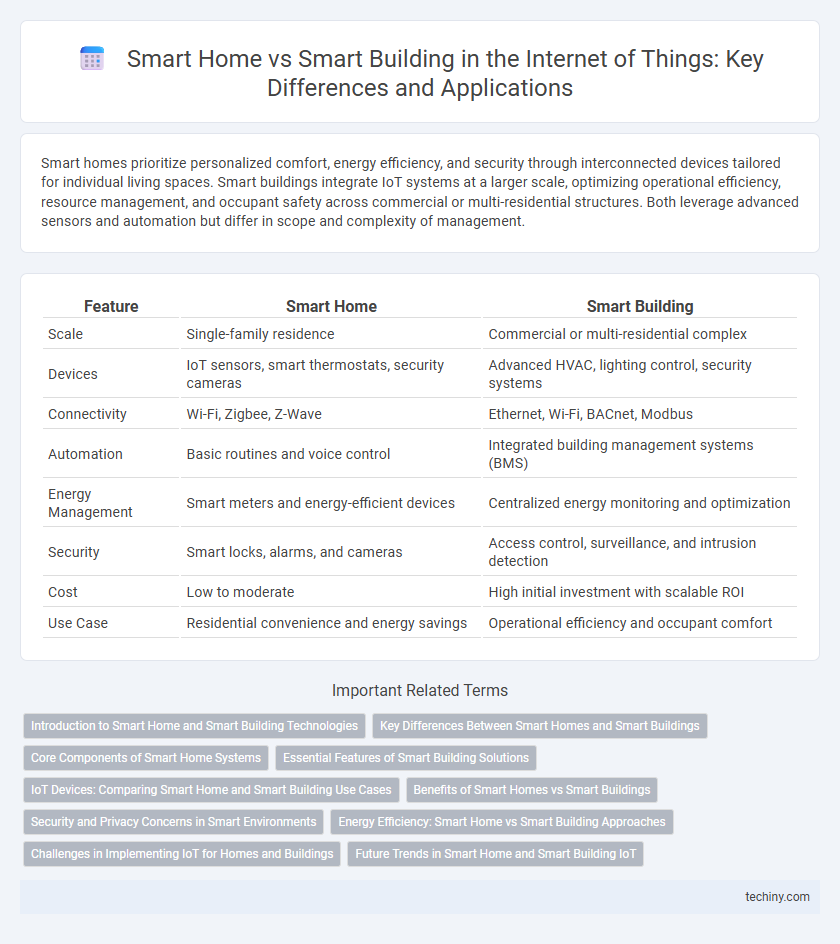Smart homes prioritize personalized comfort, energy efficiency, and security through interconnected devices tailored for individual living spaces. Smart buildings integrate IoT systems at a larger scale, optimizing operational efficiency, resource management, and occupant safety across commercial or multi-residential structures. Both leverage advanced sensors and automation but differ in scope and complexity of management.
Table of Comparison
| Feature | Smart Home | Smart Building |
|---|---|---|
| Scale | Single-family residence | Commercial or multi-residential complex |
| Devices | IoT sensors, smart thermostats, security cameras | Advanced HVAC, lighting control, security systems |
| Connectivity | Wi-Fi, Zigbee, Z-Wave | Ethernet, Wi-Fi, BACnet, Modbus |
| Automation | Basic routines and voice control | Integrated building management systems (BMS) |
| Energy Management | Smart meters and energy-efficient devices | Centralized energy monitoring and optimization |
| Security | Smart locks, alarms, and cameras | Access control, surveillance, and intrusion detection |
| Cost | Low to moderate | High initial investment with scalable ROI |
| Use Case | Residential convenience and energy savings | Operational efficiency and occupant comfort |
Introduction to Smart Home and Smart Building Technologies
Smart home technologies integrate IoT devices such as smart thermostats, lighting systems, and security cameras to enhance residential comfort, energy efficiency, and security through automation and remote control. Smart buildings leverage advanced IoT sensors and building management systems (BMS) to optimize HVAC, lighting, and access control in commercial or industrial structures, improving operational efficiency and occupant experience. Both ecosystems utilize data analytics and real-time monitoring to enable predictive maintenance and reduce energy consumption, but smart buildings often feature more complex infrastructure and scalability to support larger occupant loads.
Key Differences Between Smart Homes and Smart Buildings
Smart homes typically feature residential IoT devices designed for personal comfort, energy management, and security, whereas smart buildings incorporate integrated systems for commercial efficiency, including advanced HVAC, lighting, and access control systems. Smart buildings deploy sophisticated sensors and analytics to optimize space utilization and facility management on a larger scale compared to the typically simpler automation found in smart homes. The scale, complexity, and primary use case differentiate smart homes focused on occupants' lifestyle enhancements from smart buildings aimed at operational efficiency and sustainability in commercial environments.
Core Components of Smart Home Systems
Smart home systems rely on core components such as connected sensors, IoT-enabled devices, and centralized hubs to automate and control lighting, climate, security, and appliances. These components use wireless protocols like Zigbee, Z-Wave, and Wi-Fi to enable seamless communication and real-time monitoring within residential environments. Unlike smart buildings, which integrate complex HVAC, energy management, and access control systems for commercial spaces, smart home solutions prioritize user-friendly interfaces and personalized automation for individual households.
Essential Features of Smart Building Solutions
Smart building solutions integrate advanced IoT technologies such as centralized energy management, adaptive HVAC systems, and intelligent lighting controls to optimize operational efficiency and occupant comfort. Real-time data analytics and sensor networks enable proactive maintenance, enhanced security, and space utilization optimization, distinguishing smart buildings from basic smart home setups. These essential features contribute to sustainable building management and reduced operational costs.
IoT Devices: Comparing Smart Home and Smart Building Use Cases
IoT devices in smart homes typically enhance convenience, security, and energy efficiency through products like smart thermostats, voice assistants, and automated lighting systems tailored for individual occupants. In contrast, smart buildings deploy IoT sensors and systems at scale to optimize HVAC, lighting, security, and occupancy management, aiming for operational efficiency and sustainability in commercial or multi-tenant environments. The distinct use cases emphasize personalized comfort in smart homes versus integrated facility management and predictive maintenance in smart buildings.
Benefits of Smart Homes vs Smart Buildings
Smart homes offer personalized automation that enhances daily living comfort, energy efficiency, and security through IoT devices tailored to individual preferences. Smart buildings provide scalable solutions that optimize operational costs, improve occupant safety, and support sustainable management across commercial or multi-tenant environments. The key benefit lies in smart homes' user-centric design versus smart buildings' focus on large-scale efficiency and resource optimization.
Security and Privacy Concerns in Smart Environments
Smart homes and smart buildings both integrate IoT devices that increase vulnerability to cyberattacks, but smart buildings face amplified risks due to their larger scale and diverse user base. Security concerns in smart environments include unauthorized access, data breaches, and inadequate encryption protocols, which can compromise personal data and critical infrastructure. Privacy issues arise from continuous data collection and insufficient transparency regarding data usage, making robust security frameworks and user consent mechanisms essential for both smart homes and buildings.
Energy Efficiency: Smart Home vs Smart Building Approaches
Smart homes leverage IoT sensors and automated systems to optimize energy consumption by adjusting lighting, heating, and appliances based on occupant behavior and preferences. Smart buildings utilize advanced energy management platforms integrating HVAC, lighting, and security systems with real-time analytics to maximize energy efficiency across larger, multi-occupant environments. Both approaches reduce energy waste, but smart buildings achieve greater scalability and cost savings through centralized control and predictive maintenance technologies.
Challenges in Implementing IoT for Homes and Buildings
Implementing IoT in smart homes and smart buildings faces challenges such as data privacy concerns, complex interoperability among diverse devices, and high deployment costs. Scalability issues arise in smart buildings due to their larger infrastructure compared to homes, necessitating robust network architectures and advanced cybersecurity measures. Limited user expertise in managing IoT systems further complicates seamless integration and efficient operation across both environments.
Future Trends in Smart Home and Smart Building IoT
Future trends in smart home and smart building IoT emphasize enhanced interoperability, AI-driven automation, and edge computing to improve energy efficiency and occupant comfort. Integration of advanced sensors and machine learning algorithms enables predictive maintenance and real-time environmental monitoring, reducing operational costs. Growing adoption of 5G connectivity facilitates seamless communication between devices, fostering scalable and secure IoT ecosystems in both residential and commercial environments.
smart home vs smart building Infographic

 techiny.com
techiny.com